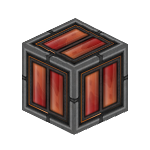Power Auxiliary
| This page is currently a stub. Please help us out by expanding it. |
| This article is a work-in-progress. Edits are welcome, however please keep in mind that they may be overwritten or removed if they are not in line with the intention of the article. |
| Power Auxiliary | |
|---|---|
 | |
| Hit Points | 50 |
| Armor | 0.0% |
| Mass | 0.10 |
| Luminosity | none |
| Data Value (ID) | 978 |
Power Auxiliaries are the result of combining Power Capacitors and Power Reactors into a single block. Their power regeneration scales similar to the normal power reactors except that only the group count matters and that their soft cap is also per group. They also have the ability to store power internally. You can turn these Auxiliaries "On" and "Off" by toggling it in your weapons menu. - On: Aux regeneration gets added to the main ship, any internally stored power is drained into the main ship's Power Capacitors. - Off: Aux regeneration charges their own internal power storage at a slow rate. WARNING: These blocks are highly volatile! If a group loses a block, it will create an explosive chain event that can destroy an entire reactor group in less than 2 minutes!
Contents
Production
| Production Info | |||||
|---|---|---|---|---|---|
| Produced in a | Basic Factory |  |
|||
| Requires | To create | ||||
| Power Reactor Module | x1 |
 |
Power Auxiliary | x1 |
 |
| Power Capacitor | x1 |
 |
|||
Usage
Power Auxiliaries do not have any shape-based grouping bonus, and work best in large, continuous groupings, much like Power Capacitors. However, they also share the same "soft-cap" on effectiveness as Power Reactors, and will become less efficient (in terms of power output per block) when their total regen (while on) approaches 2,000,000.
Power Auxiliaries are off by default, when first placed. In this state, they generate power at 20% of their maximum regen rate (which is reached when they are turned on), and store the generated power in the auxiliary power pool, displayed as an orange bar on the right of the HUD. This pool is separate from the "standard" power pool used by all other ship systems. Although it may seem unintuitive that the system has an "off" state, this has situational relevance as a quick energy resupply after firing an "alpha" weapon (one which has a high damage, high energy cost, and high cooldown); firing such a weapon and then activating the Power Auxiliary system would quickly refill the ship's storage, covering what can otherwise be a temporarily-crippling power usage spike.
When turned on, all power stored in the auxiliary power pool is transferred at a rate equivalent to 25% of the auxiliary pool's total size until the pool is empty. The auxiliaries will continue generating (with power transferred directly to the main pool) at this rate until turned off. Because transfer rate is always greater than regen rate, once the auxiliary pool is emptied, effective output of the system becomes equal to its regen rate, rather than the transfer rate.
Although the power generation of an auxiliary reactor is not insignificant, neither is the risk involved in their use. When any block in a Power Auxiliary group is destroyed, a series of explosions will occur throughout that group, with overall severity (quantity, size, and damage of the explosions) being proportional to the block count of the group affected. Depending on reactor size and mitigative measures taken (eg. layers or rods of armor throughout the grouping), damage may be either crippling or relatively tolerable.
It is relevant to note that the Power Auxiliary system does not have a computer module available. This means that the entire system is either on or off at any given point, and that individual groupings cannot be toggled on or off. The power capacity of an auxiliary power system is also shared, rather than being confined to invididual groupings.
Formulas
The various details of a Power Auxiliary system are defined by a number of formulas, which are listed below. In many cases, Desmos graphs (an interactive online graphing service) are available to provide a more responsive way to view these formulas.
| Symbol | Value |
|---|---|
| p | Power regen (on) |
| q | Power regen (off) |
| bg | Block count of auxiliary group in question |
| bt | Total block count of all auxiliary groups on the entity |
| c | Auxiliary power capacity |
| t | Transfer rate from auxiliary to primary power pool |
| er | Explosion radius |
| ed | Explosion damage |
| en | Number of explosions |